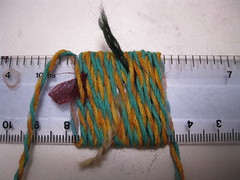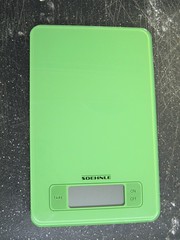Sometimes you will run across yarn in
various formats (skeins, hanks, or loose) that will have no
identifying information about them. This happens fairly often if you
purchase yarn from a garage or estate sale, a thrift store, or are
given someone's old stash. Even though these treasures are unmarked,
there are ways to gather information that can help you determine what
kinds of projects would be appropriate.
First we want to determine the fiber
content of the yarn. While you may not know the specific content
amounts is the yarn is a blend, you can determine the class of fiber
in most cases. To begin with, give the yarn a good feel. Run your
hands over the yarn and take in all the qualities of it. After some
practice, you will become adept at knowing the feel of different base
fibers. Cotton is easiest to detect using feel, as it has a smooth
and cool feel. Acrylic and wool can be trickier, since higher quality
acrylics are soft and fluffy, which cause them to take on a similar
feel to wool blends.
There is a way to tell, however,
whether a yarn is acrylic or wool.
NOTE: PLEASE KEEP OUT OF THE REACH OF CHILDREN. Take a glass jar with a lid on it and write BLEACH / POISON on the side. Put a small amount of bleach in the jar and place a small cutting of the yarn in the bleach. Put it way up high, far from the reach of children, pets, or anyone else. When you check the jar in approximately 12-24 hours, if the yarn has degraded or disappeared, it is wool or wool blend yarn. Wool disintegrates in bleach. If it looks the same after 24 hours, it is acrylic.
Now we have some idea of what our yarn
consists of. Next thing that we need to know is the weight (fingering
or bulky?) and how many yards of yarn we have! The table below lists
the different weights of yarn, the number of yards per pound, and the
number of wraps per inch. Wraps per inch refers to a method of
determining weight using a ruler.
| WEIGHT | YARDS PER POUND | WRAPS PER INCH |
| Zephyr | Over 6000 YPP | Over 45+ WPI |
| Cobweb | Approx. 6000 YPP | Approx. 40+ WPI |
| Lace | 3000-6000 YPP | 36-40 WPI |
| Baby | 2400-3000 YPP | 30-36 WPI |
| Fingering | 1800-2400 YPP | 24-30 WPI |
| Sport | 1300-1800 YPP | 18-24 WPI |
| DK | 1000-1400 YPP | 12-18 WPI |
| Worsted | 900-1100 YPP | 10-12 WPI |
| Aran | 700-1000 YPP | 6-10 WPI |
| Bulky | 400-700 YPP | Approx. 8 WPI |
| Super Bulky (Chunky) | 400 or less YPP | Less than 8 WPI |
So now we have all the numbers we need
to figure out the weight and yardage of our yarn. The first thing to do
is determine how many wraps per inch our mystery yarn is. Take a
ruler and mark off 2 inches on the ruler. Take the yarn and wrap it (not too
loosely or too tightly) around the ruler, making sure that the yarn
does not overlap or leave gaping spaces, but is placed one loop
snugly against another. Continue to wrap the yarn in this manner for
2 inches, count the number of wraps created, and divide by 2. Voila!
That is the number of wraps per inch of the yarn you have. Once you
know the wraps per inch, you can get a good idea of the weight of the
yarn by referencing the chart above.
For example: You take your mystery yarn and do the wraps as per instructions above. Over 2 inches, you have 22 wraps. So you take 22 and divide it by 2 to get 11 wraps per inch. So per the chart above, this mystery yarn is worsted weight.
Next we want to determine the yardage
of the mystery yarn that we have. The easiest and most accurate way
to do this is to weigh an amount of yarn (I use 10 yards) and use
the weight to determine the yards per pound. You want to measure this
accurately so use a kitchen or postage scale if possible, or even a
grocery store produce scale. You can use a bathroom scale, but it is
likely to be inaccurate because it is not sensitive enough.
So take ten yards of yarn and weigh that. Then divide that weight by 10 to get the weight per yard. Then weigh the ball or hank of yarn and divide by the weight per yard. That will give you the approximate yardage. As you can see above, worsted weight yarn is generally between 900 and 1100 yards per pound.
While these steps may not get you the
exact information that would be on a label, it can nevertheless be
very useful in determining the type and size of project appropriate
for those mystery yarn balls!



Just wanted to say thanks so much for this information, everything I needed to know and easy to understand. Wonderful!
ReplyDeleteRun your hands over the yarn and take in all the qualities of it. After some practice, acrylic lace pool deck
ReplyDeleteExcellent information for an avid thrifter. Thanks so much.
ReplyDeleteFound a nice bag of unknown yarn. Wanted more info and found your site. The info here has been very helpful. My yarn samples are sitting in little labeled bottles of bleach and waiting for results. THANX again!
ReplyDeletethank you for this. I have a question on the number of wraps. I have measured my yarn and it comes out to 9WPI. This puts it at either Aran (6-10) or Bulky (8WPI). I thought bulky was chunky which I thought was alot thicker than Aran. So am i using aran or chunky, as the pattern gauge are completely different but WPI falls on both.
ReplyDelete